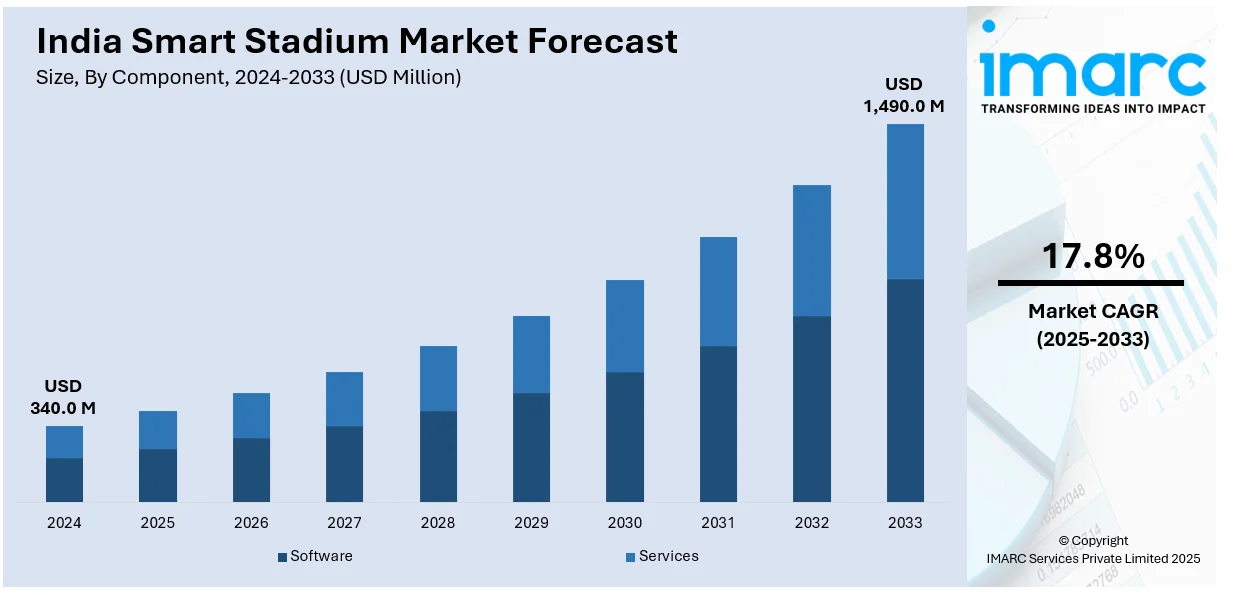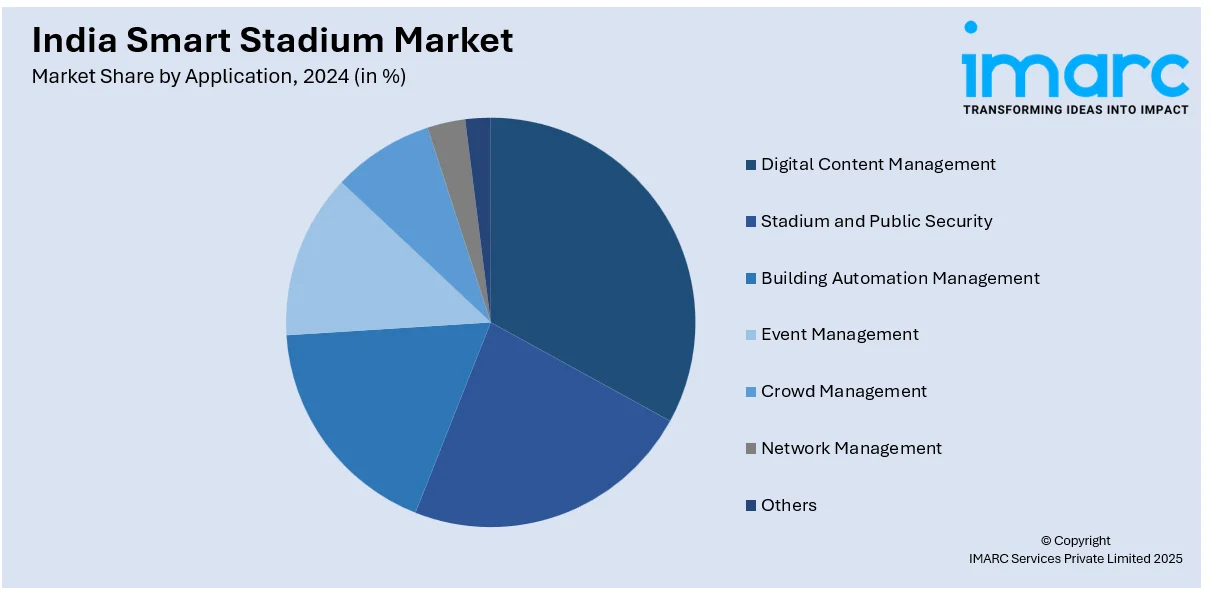
India Smart Stadium Market Size, Share, Trends and Forecast by Component, Deployment Model, Application, and Region, 2025-2033
India Smart Stadium Market Overview:
The India smart stadium market size reached USD 340.0 Million in 2024. Looking forward, IMARC Group expects the market to reach USD 1,490.0 Million by 2033, exhibiting a growth rate (CAGR) of 17.8% during 2025-2033. The rising investments in sports infrastructure, increasing demand for enhanced fan experiences, the adoption of advanced technologies like the Internet of Things (IoT), 5G, and artificial intelligence (AI), digital ticketing solutions, and smart security systems are contributing to the market expansion.
|
Report Attribute
|
Key Statistics
|
|---|---|
|
Base Year
|
2024
|
|
Forecast Years
|
2025-2033
|
|
Historical Years
|
2019-2024
|
| Market Size in 2024 | USD 340.0 Million |
| Market Forecast in 2033 | USD 1,490.0 Million |
| Market Growth Rate (2025-2033) | 17.8% |
India Smart Stadium Market Trends:
Integration of 5G Technology for Enhanced Connectivity
The smart stadium sector in India is undergoing a significant transformation due to the deployment of 5G technology, which improves connection and data speed and enables real-time fan interaction. With the growing popularity of 5G deployment in India, large stadiums are utilizing this technology to offer immersive experiences. It is anticipated that around 350 million Indians would have 5G by 2025, accounting for about 27% of all mobile subscribers. 5G networks offer ultra-low latency and increased capacity, allowing spectators to enjoy smooth video streaming, augmented reality (AR) experiences, and interactive content within stadium grounds. For example, with 5G connectivity, viewers may experience various camera viewpoints, quick replays, and tailored content right on their devices. This technology also improves smart stadium operations by automating crowd control, providing smart parking options, and improving security monitoring. Furthermore, 5G enables the deployment of IoT sensors throughout stadiums, providing real-time data collecting for better energy management and infrastructure maintenance.

To get more information on this market, Request Sample
Adoption of AI-Powered Solutions for Stadium Management
The use of artificial intelligence (AI) is becoming a prominent trend in India's smart stadium business, transforming crowd management, security, and individualized fan experiences. By 2025, India's AI market is expected to develop at a CAGR of 20.2%, with a valuation of over USD 7.8 Billion. AI-powered technologies are changing stadium security by using facial recognition, behavior analysis, and predictive analytics to detect possible threats and assure crowd safety. For example, face recognition software may quickly detect unauthorized persons or questionable activity, reducing security concerns during important events. Aside from this, AI is improving ticketing systems by forecasting demand surges, creating dynamic pricing tactics, and providing frictionless access via biometric verification. Furthermore, AI chatbots are gaining popularity for offering real-time information on seating arrangements, concession stands, and event schedules, therefore increasing audience engagement. In addition, AI-powered data analytics are improving stadium maintenance by forecasting equipment breakdowns, monitoring energy use, and assuring proactive infrastructure management. By 2024, approximately 60% of India's smart stadiums are planned to use AI-powered security technologies to improve event safety and operational efficiency, which will further strengthen the market growth.
India Smart Stadium Market Segmentation:
IMARC Group provides an analysis of the key trends in each segment of the market, along with forecasts at the region/country level for 2025-2033. Our report has categorized the market based on component, deployment model, and application.
Component Insights:
- Software
- Services
The report has provided a detailed breakup and analysis of the market based on the component. This includes software and services.
Deployment Model Insights:
- On-premises
- Cloud-based
A detailed breakup and analysis of the market based on the deployment model have also been provided in the report. This includes on-premises and cloud-based.
Application Insights:

- Digital Content Management
- Digital Signage
- Audio and Video Management
- Others
- Stadium and Public Security
- Video Surveillance
- Cybersecurity
- Emergency and Disaster Management
- Physical Security Information Management
- Security Scanning, Imaging and Metal Detection
- Others
- Building Automation Management
- Parking Management Systems
- Energy Management Systems
- Facility Management Systems
- Event Management
- Event Marketing and Management
- Ticketing Management
- Workforce Management
- Crowd Management
- Network Management
- Others
The report has provided a detailed breakup and analysis of the market based on the application. This includes digital content management (digital signage, audio and video management, and others), stadium and public security (video surveillance, cybersecurity, emergency and disaster management, physical security information management, security scanning, imaging and metal detection, and others), building automation management (parking management systems, energy management systems, and facility management systems), event management (event marketing and management, ticketing management, and workforce management), crowd management, network management, and others.
Regional Insights:
- North India
- South India
- East India
- West India
The report has also provided a comprehensive analysis of all the major regional markets, which include North India, South India, East India, and West India.
Competitive Landscape:
The market research report has also provided a comprehensive analysis of the competitive landscape. Competitive analysis such as market structure, key player positioning, top winning strategies, competitive dashboard, and company evaluation quadrant has been covered in the report. Also, detailed profiles of all major companies have been provided.
India Smart Stadium Market News:
- January 2025: Mangaluru announced its plans to open a state-of-the-art indoor stadium for badminton and Kabaddi that would match national standards. The fully equipped facility, which costs Rs 33 crore, would be available for use by the end of March. The facility will allow the city to host national-level professional Kabaddi and shuttle badminton championships. The stadium will also offer specific training facilities for regional shuttle badminton and kabaddi players.
- April 2024: Omaxe, a well-known sports firm, announced its intentions to build India's first integrated smart multi-sports facility in Delhi's Dwarka district. This enormous project will include an international cricket and football stadium, an indoor sports arena, and a retail and hotel complex.
India Smart Stadium Market Report Coverage:
| Report Features | Details |
|---|---|
| Base Year of the Analysis | 2024 |
| Historical Period | 2019-2024 |
| Forecast Period | 2025-2033 |
| Units | Million USD |
| Scope of the Report |
Exploration of Historical Trends and Market Outlook, Industry Catalysts and Challenges, Segment-Wise Historical and Future Market Assessment:
|
| Components Covered | Software, Services |
| Deployment Models Covered | On-premises, Cloud-based |
| Applications Covered |
|
| Regions Covered | North India, South India, East India, West India |
| Customization Scope | 10% Free Customization |
| Post-Sale Analyst Support | 10-12 Weeks |
| Delivery Format | PDF and Excel through Email (We can also provide the editable version of the report in PPT/Word format on special request) |
Key Benefits for Stakeholders:
- IMARC’s industry report offers a comprehensive quantitative analysis of various market segments, historical and current market trends, market forecasts, and dynamics of the India smart stadium market from 2019-2033.
- The research report provides the latest information on the market drivers, challenges, and opportunities in the India smart stadium market.
- Porter's five forces analysis assist stakeholders in assessing the impact of new entrants, competitive rivalry, supplier power, buyer power, and the threat of substitution. It helps stakeholders to analyze the level of competition within the India smart stadium industry and its attractiveness.
- Competitive landscape allows stakeholders to understand their competitive environment and provides an insight into the current positions of key players in the market.
Key Questions Answered in This Report
The India smart stadium market was valued at USD 340.0 Million in 2024.
The India smart stadium market is projected to exhibit a CAGR of 17.8% during 2025-2033, reaching a value of USD 1,490.0 Million by 2033.
The key drivers for the India smart stadium market include rising investments in sports infrastructure, increasing demand for enhanced fan experiences, and the adoption of advanced technologies like IoT, 5G, AI, digital ticketing, and smart security systems. These factors are contributing to the rapid growth and transformation of the smart stadium sector in India.
Need more help?
- Speak to our experienced analysts for insights on the current market scenarios.
- Include additional segments and countries to customize the report as per your requirement.
- Gain an unparalleled competitive advantage in your domain by understanding how to utilize the report and positively impacting your operations and revenue.
- For further assistance, please connect with our analysts.
 Request Customization
Request Customization
 Speak to an Analyst
Speak to an Analyst
 Request Brochure
Request Brochure
 Inquire Before Buying
Inquire Before Buying




.webp)




.webp)












